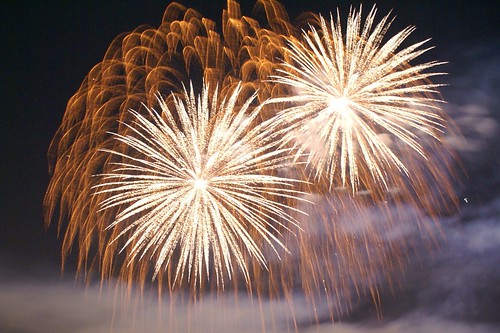America is about to blow up a bunch of stuff for its 240th birthday. I love it! Who doesn’t love fireworks? Well, aside from animals like my childhood dog, who invariably hid under the bed in cowering terror. And people who have had enough of explosions to last them a lifetime. People who are triggered or kept awake by loud bangs. People who are phobic about fire. All right, so there’s a long list of people and other animals who don’t like fireworks. But hopefully, even if you can’t stand ’em, you’ll be able to enjoy the geology, chemistry, and physics of them.
Oh, yeah, definitely geology. There’d be no fireworks without geology. Geologist High Maintenance Mom provides a great overview of the science of fireworks, explaining in kid-friendly ways how physics, chemistry and geology combine to create pyrotechnic magic. She’s a great resource to start with if you want to make your trip to see the fireworks show a fun teachable moment for your kids.
For a more adult-oriented overview, see this excellent article on Geology.com. Lots of diagrams and nifty information, including this section regarding how geology fits in. Those beautiful colors wouldn’t be there if geologists weren’t finding the minerals that create them:
What Causes the Colors?
Chemistry holds the secrets to the color of a fireworks burst. The colors that you see in the sky are determined by metal salts that are deliberately added in very small amounts to the stars when they are manufactured.
As the stars burn the metal atoms absorb energy, become excited and emit a specific color of light. Some of the metals that produce the colors of fireworks are tabulated here.

Strontium plus copper! Copper! Maybe some sodium!
Speaking of sodium, did you know you can do an awesome flame test using stuff you can pick up at the grocery store? Check out llinois State Museum Geology Online’s “A Burst of Light (pdf)” lesson – this is something you can, with proper precautions, do safely at home or in the classroom.
So take a geology field trip if you’re in the States today and go see a fireworks display. Raise a beer to the geologists whose ability to unearth (ha) minerals made the whole thing possible. And drink a toast to the chemists and physicists and pyromaniacs who also helped.
Science: making awesome things awesomer since humans invented it.
A version of this post was originally published at Scientific American.






With apologies for going somewhat off topic, this was the most recent halfway relevant post I could find.
I saw a rather cool looking hill last weekend, from a distance, and made the idle assumption that it could have been a volcano, where part of the top had been blown off – https://en.wikipedia.org/wiki/Roseberry_Topping#/media/File:Roseberry_topping_north_side.jpg. Hmm, maybe Dana would like it, I thought to myself. And went to track down some details. And, well, it’s sandstone, so now I’m even more intrigued. I wondered if you might be interested in a series on weird, misleading geology…